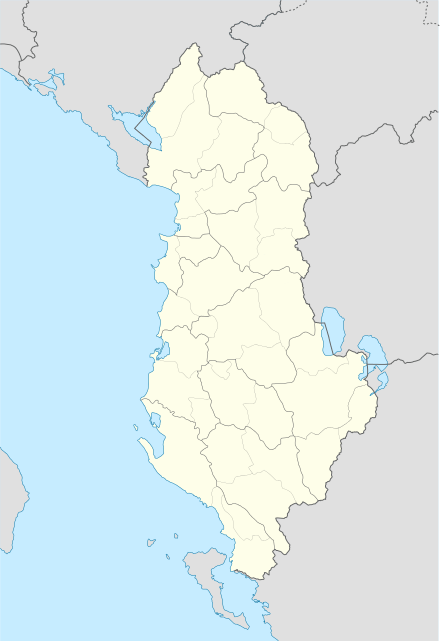Petran
Petran is a village and a former municipality in the Gjirokastër County, southern Albania. At the 2015 local government reform it became a subdivision of the municipality Përmet.[1] The population at the 2011 census was 1,622.[2] The municipal unit consists of the villages Petran, Leshnicë, Leusë, Lipë, Qilarishtë, Badilonjë, Benjë-Novoselë, Delvinë, Kaludh, Lupckë, Gjinakar (Gjinkar), Ogdunan, Isgar, Lipivan-Trabozishtë, Tremisht and Bodar. There are a couple of restaurants that look out over the Vjosa river.[3][4]
Petran | |
|---|---|
 Petran | |
| Coordinates: 40°12′N 20°24′E | |
| Country | |
| County | Gjirokastër |
| Municipality | Përmet |
| Population (2011) | |
| • Municipal unit | 1,622 |
| Time zone | UTC+1 (CET) |
| • Summer (DST) | UTC+2 (CEST) |
| Vehicle registration | PR |
Demographics
The village of Lipë is inhabited by inhabitants whose mother tongue is Albanian.[5]
Notable people
- Stath Melani, Orthodox priest and participant in the Congress of Manastir, from Melan.[6]
gollark: It's vaguely weird that you can apparently *kill* people fine, but not *blind* them.
gollark: I'm not convinced that they would actually care much about war-criming people.
gollark: I mean, it's a nice color.
gollark: What sort of stuff *can* you do with just laser pointers other than just, well, setting things on fire and shining them at things?
gollark: Spirit is very knowledgeable, but will also ruthlessly correct any mistake anyone makes.
References
- Law nr. 115/2014 Archived 2015-09-24 at the Wayback Machine
- 2011 census results Archived 2016-03-04 at the Wayback Machine
- http://www.2-albania.com
- Greece – Albania Neighbourhood Programme Archived 2012-03-27 at the Wayback Machine
- Hammond, Nicholas Geoffrey Lemprière (1967). Epirus: the Geography, the Ancient Remains, the History and Topography of Epirus and Adjacent Areas. Oxford: Clarendon Press. pp. 274–275. ISBN 9780198142539.CS1 maint: ref=harv (link) "I visited Lipa and found that all the inhabitants spoke Albanian as their native tongue."
- Vatra e kulturës (in Albanian). Shtëpija Qëndrore e Krijimtarisë Popullore. 1969. p. 30.
This article is issued from Wikipedia. The text is licensed under Creative Commons - Attribution - Sharealike. Additional terms may apply for the media files.

